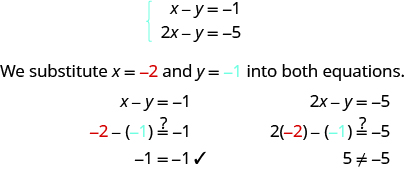| << Chapter < Page | Chapter >> Page > |
Before you get started, take this readiness quiz.
In Solving Linear Equations and Inequalities we learned how to solve linear equations with one variable. Remember that the solution of an equation is a value of the variable that makes a true statement when substituted into the equation.
Now we will work with systems of linear equations , two or more linear equations grouped together.
When two or more linear equations are grouped together, they form a system of linear equations.
We will focus our work here on systems of two linear equations in two unknowns. Later, you may solve larger systems of equations.
An example of a system of two linear equations is shown below. We use a brace to show the two equations are grouped together to form a system of equations.
A linear equation in two variables, like 2 x + y = 7, has an infinite number of solutions. Its graph is a line. Remember, every point on the line is a solution to the equation and every solution to the equation is a point on the line.
To solve a system of two linear equations, we want to find the values of the variables that are solutions to both equations. In other words, we are looking for the ordered pairs ( x , y ) that make both equations true. These are called the solutions to a system of equations .
Solutions of a system of equations are the values of the variables that make all the equations true. A solution of a system of two linear equations is represented by an ordered pair ( x , y ).
To determine if an ordered pair is a solution to a system of two equations, we substitute the values of the variables into each equation. If the ordered pair makes both equations true, it is a solution to the system.
Let’s consider the system below:
Is the ordered pair a solution?

The ordered pair (2, −1) made both equations true. Therefore (2, −1) is a solution to this system.
Let’s try another ordered pair. Is the ordered pair (3, 2) a solution?

The ordered pair (3, 2) made one equation true, but it made the other equation false. Since it is not a solution to both equations, it is not a solution to this system.
Determine whether the ordered pair is a solution to the system:
ⓐ ⓑ



Notification Switch
Would you like to follow the 'Elementary algebra' conversation and receive update notifications?